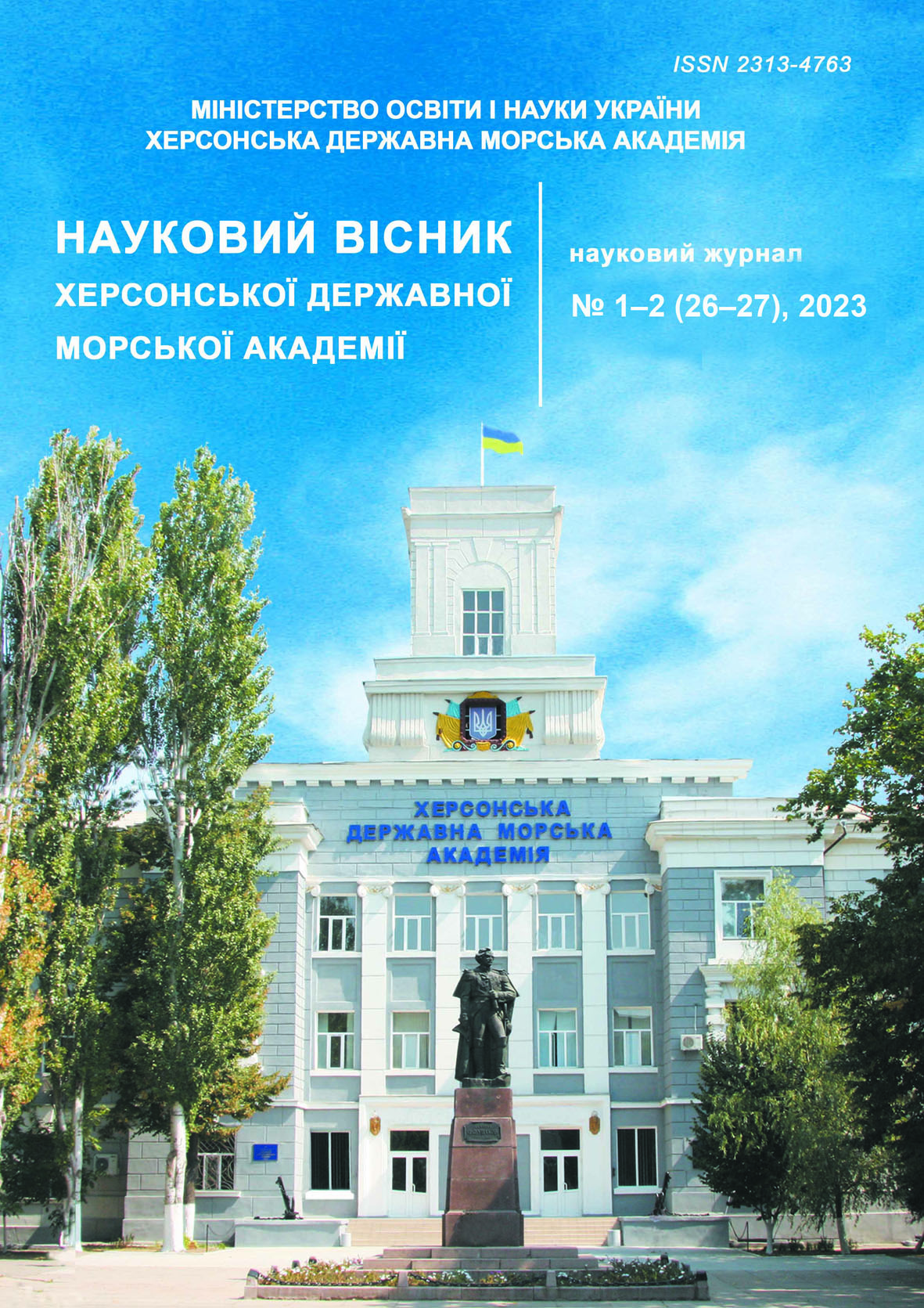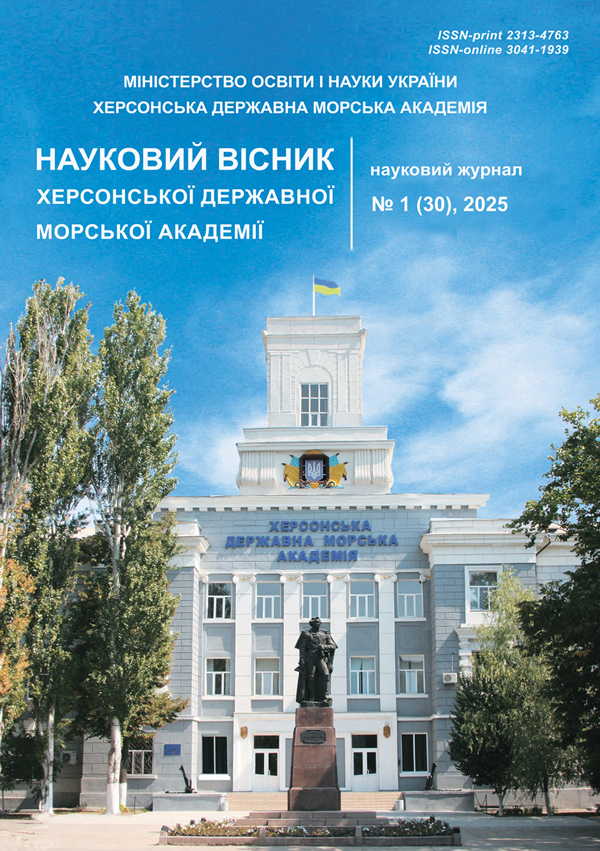DETERMINING THE IMPACT OF THE HUMAN OPERATOR FACTOR USING A NAVIGATION SIMULATOR
https://doi.org/10.33815/2313-4763.2025.1.30.158-170
Abstract
As maritime operations become increasingly complex, there is a growing need for objective, scalable methods to evaluate seafarer competence beyond traditional instructor-based assessments. This study presents a comprehensive, data-driven framework for analyzing cadet performance in maritime simulator exercises, utilizing state-of-the-art unsupervised learning and explainable AI. The research draws on multivariate time-series data from navigational simulations, capturing vessel dynamics, control actions, and environmental parameters across dozens of features. A rigorous preprocessing pipeline was applied, combining statistical feature aggregation and redundancy reduction through Pearson correlation and Mutual Information. This yielded a compact, yet informative feature set encompassing control inputs, navigational states, and vessel motions. To offset limited number of sessions small in the dataset, each simulation was split into meaningful intervals by applying rolling window statistics. Each window was then encoded as a summary vector, reflecting both central tendencies and temporal variability. The analysis employed the HDBSCAN clustering algorithm, which excels in detecting groups of variable density and naturally identifies outlier behaviors—critical in the context of training evaluation. The resulting clusters were projected into lower-dimensional space via t-SNE, providing interpretable visualizations of cadet performance patterns. To further elicit the distinguishing characteristics of each group, a linear Support Vector Machine was trained to predict cluster membership, with SHapley Additive exPlanations (SHAP) attributing each decision to underlying features. Key findings reveal that clusters align with distinct navigational strategies: stable, conservative approaches are differentiated from more dynamic or risk-prone styles by features such as roll velocity, yaw rate, and engine RPM. Sessions flagged as outliers typically exhibited abrupt maneuvers or inconsistent control usage, highlighting potential skill gaps. The SHAP-based interpretability layer transforms complex model outputs into actionable instructional feedback, enabling targeted interventions and tailored training. Overall, this automated approach has potential to become a transparent, scalable alternative to subjective grading in maritime education, with significant implications for enhancing safety and developing individualized learning pathways. The proposed system demonstrates strong potential for integration into real-world training environments and continuous improvement as more operational data becomes available.
References
2. International Maritime Organization. (n.d.). The human element. IMO. Retrieved May 24, 2025, from https://www.imo.org/en/OurWork/HumanElement.
3. Munim, Z. H., Dushenko, M., Jimenez, V. J., Shakil, M. H., & Imset, M. (2020). Big data and artificial intelligence in the maritime industry: a bibliometric review and future research directions. Maritime Policy & Management, 47(5), 577–597. https://doi.org/10.1080/03088839.2020.1788731.
4. Nguyen, D., Vadaine, R., Hajduch, G., Garello, R., &; Fablet, R. (2021). GeoTrackNet-A Maritime Anomaly Detector using Probabilistic Neural Network Representation of AIS Tracks and A Contrario Detection. IEEE Transactions on Intelligent Transportation Systems, 1–13. https://doi.org/10.1109/TITS.2021.3055614.
5. Ana, Mateus Sant', Guoyuan Li, and Houxiang Zhang. "A Decentralized Sensor Fusion Approach to Human Fatigue Monitoring in Maritime Operations." 2019 IEEE 15th International Conference on Control and Automation (ICCA), July 1, 2019, 1569–74. https://doi.org/10.1109/ICCA.2019.8899708.
6. Xiao, Z., Fu, X., Zhang, L., Zhang, W., Liu, R. W., Liu, Z., & Goh, R. S. M. (2020). Big Data Driven Vessel Trajectory and Navigating State Prediction With Adaptive Learning, Motion Modeling, and Particle Filtering Techniques. IEEE Transactions on Intelligent Transportation Systems, 1–14. https://doi.org/10.1109/TITS.2020.3040268.
7. BIMCO/ICS, 2021. Seafarer Workforce Report: The global supply and demand for seafarers in 2021. Available at: https://www.ics-shipping.org/publication/seafarer-workforce-report-2021-edition/.
8. Eurydice (2021). Draft Law on the Organization and Integration of Vocational Training. Available at: https://eacea.ec.europa.eu/national-policies/eurydice/content/national-reforms-vocational-education-andtraining-and-adult-learning-70_en.
9. Munim, Ziaul & Kim, Tae-eun. (2023). A Review of Learning Analytics Dashboard and a Novel Application in Maritime Simulator Training. 10.54941/ahfe1003158.
10. W. C. (2025). Wärtsilä Navigation simulator NTPRO 5000. WäRtsilä Navigation Simulator NTPRO 5000. Retrieved May 27, 2025, from https://www.wartsila.com/marine/products/simulation-and-training/navigational-simulators/naviga tion-simulator-ntpro-5000.
11. Good, I. J. The Philosophy of Exploratory Data Analysis. Philosophy of Science. 1983;50(2):283–295. https://doi.org/10.1086/289110.
12. Benesty, J., Chen, J., Huang, Y., Cohen, I. (2009). Pearson Correlation Coefficient. In: Noise Reduction in Speech Processing. Springer Topics in Signal Processing, vol 2. Springer, Berlin, Heidelberg. https://doi.org/10.1007/978-3-642-00296-0_5.
13. Veyrat-Charvillon, N., & Standaert, F. X. (2009). Mutual information analysis: how, when, and why?. In International workshop on cryptographic hardware and embedded systems (pp. 429–443). Berlin, Heidelberg: Springer Berlin Heidelberg.
14. Martínez Vásquez, D. A., Posada-Quintero, H. F., Rivera Pinzón, D. M. (2023). Mutual Information between EDA and EEG in Multiple Cognitive Tasks and Sleep Deprivation Conditions. Behavioral Sciences. 2023; 13(9):707. https://doi.org/10.3390/bs13090707.
15. Kamalov, F., Sulieman, H., Alzaatreh, A., Emarly, M., Chamlal, H., Safaraliev, M. (2025). Mathematical Methods in Feature Selection: A Review. Mathematics. 2025; 13(6):996. https://doi.org/10.3390/math13060996.
16. Yong, Yu, Xiaosheng, Si, Changhua, Hu, Jianxun Zhang (2019). A Review of Recurrent Neural Networks: LSTM Cells and Network Architectures. Neural Comput 2019; 31 (7): 1235–1270. https://doi.org/10.1162/neco_a_01199.
17. Chen, T., & Guestrin, C. (2016). XGBoost. KDD '16: Proceedings of the 22nd ACM SIGKDD International Conference on Knowledge Discovery and Data Mining, 785–794. https://doi.org/10.1145/2939672.2939785.
18. LIME: Ribeiro, Marco Tulio, Sameer Singh, and Carlos Guestrin. "Why should I trust you?: Explaining the predictions of any classifier." Proceedings of the 22nd ACM SIGKDD International Conference on Knowledge Discovery and Data Mining. ACM, 2016.
19. Ahmed, M., Seraj, R. (2020). Islam SMS. The K-means Algorithm: A Comprehensive Survey and Performance Evaluation. Electronics; 9(8):1295. https://doi.org/10.3390/electronics9081295.
20. Wan, H., Wang, H., Scotney, B., and Liu, J. (2019). "A Novel Gaussian Mixture Model for Classification," 2019 IEEE International Conference on Systems, Man, and Cybernetics (SMC), Bari, Italy, pp. 3298–3303, https://doi.org/10.1109/SMC.2019.8914215.
21. Khan, K., Rehman, S. U., Aziz, K., Fong, S. and Sarasvady, S. (2014). "DBSCAN: Past, present and future," The Fifth International Conference on the Applications of Digital Information and Web Technologies (ICADIWT 2014), Bangalore, India, pp. 232–238, https://doi.org/10.1109/ICADIWT.2014.6814687.
22. Campello, R.J.G.B., Moulavi, D., Sander, J. (2013). Density-Based Clustering Based on Hierarchical Density Estimates. In: Pei, J., Tseng, V.S., Cao, L., Motoda, H., Xu, G. (eds) Advances in Knowledge Discovery and Data Mining. PAKDD 2013. Lecture Notes in Computer Science, vol 7819. Springer, Berlin, Heidelberg. https://doi.org/10.1007/978-3-642-37456-2_14.
23. Cortes, C., Vapnik, V. (1995). Support-vector networks. Mach Learn 20, 273–297, 1995. https://doi.org/10.1007/BF00994018.
24. Cristianini, N., Shawe-Taylor, J. (2000). An Introduction to Support Vector Machines and Other Kernel-Based Learning Methods. Cambridge University Press.
25. Hsu, C.-W., Chang, C.-C., & Lin, C.-J. (2016). A Practical Guide to Support Vector Classification.
26. Guyon, I., Weston, J., Barnhill, S., & Vapnik, V. (2002). Gene Selection for Cancer Classification using Support Vector Machines. Machine Learning, 46(1), 389–422.
27. Lundberg, S. M., & Lee, S.-I. (2017). A Unified Approach to Interpreting Model Predictions. Advances in Neural Information Processing Systems, 30, 4765–4774.
28. Strumbelj, Erik and Kononenko, Igor (2010). An Efficient Explanation of Individual Classifications using Game Theory. J. Mach. Learn. Res. 11 (3/1/2010), 1–18.






